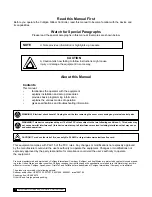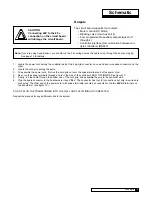
Installation
Cable Routing
All input and output connections to the circuit board are 24 volt or less.
Although the cables do not have to be run in conduit, it is necessary that long runs of cable be supported or
protected by strapping them to the equipment piping. If conduit will be used to route the shielded cables, three
factors must be considered:
1.
DO NOT
share the same conduit or raceway with 120 volt or higher circuits.
2. Keep cables at least 6 inches away from 120 volt or higher electrical circuits.
3. GROUND the conduit (if metallic) to a known “earth ground” location.
A series of holes are located on the sides of the controller (see Figure 6 and 7). Strain relief fittings are provided
with the controller enclosure for interconnecting wiring. Install the plastic fittings as needed. Remove the com-
pression nut and rubber sleeve from each fitting. Prior to connection of the cable wires to the circuit board, slide
the compression nut and sleeve over the cable for the wiring connections. When wiring is completed, apply a
small amount of silicone to the rubber sleeve and reassemble. This will assure all wiring is secure and assist
in making the tightening of the fitting easier. Insert the plugs provided to block any holes not used for wiring or
other accessories.
Right Side View
Brine Reclaim Solenoid
(optional)
Input Connection
for Flow Sensor
Output Connection
for Remote
Accessories
Input Connection
for Remote
Accessories
24 Volt Power
Input Connection
Brine Reclaim Solenoid
(optional)
Brine Refill Valve
Blocking Solenoid for
Alternating Operation
Left Side View
Figure 6
Figure 7
Installation
6
5
CULLIGAN GLOBAL ELECTRONIC CONTROLLER
Summary of Contents for GBE
Page 62: ...Menu Overview Continued on page 61 59 CULLIGAN GLOBAL ELECTRONIC CONTROLLER ...
Page 63: ...Menu Overview Menu Overview 60 ...
Page 64: ...Menu Overview Continued from page 59 61 CULLIGAN GLOBAL ELECTRONIC CONTROLLER ...
Page 65: ...Menu Overview Menu Overview 62 ...
Page 72: ...Appendix D 69 CULLIGAN GLOBAL ELECTRONIC CONTROLLER ...










































